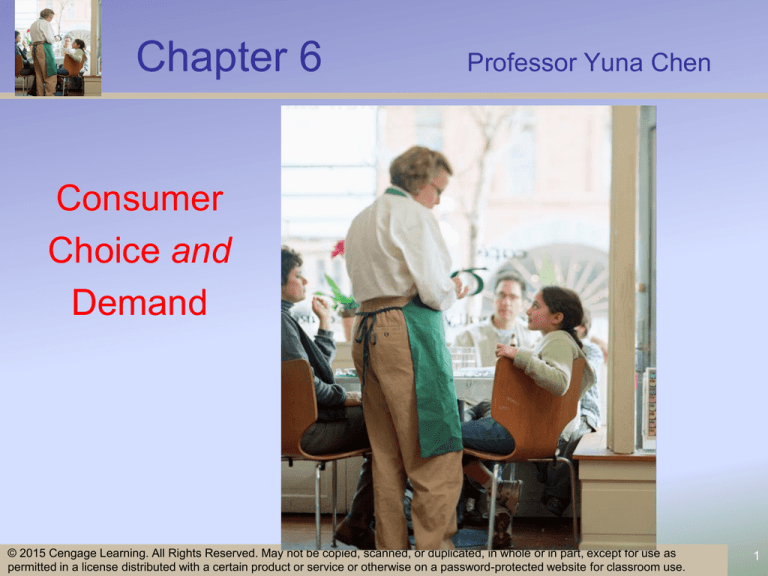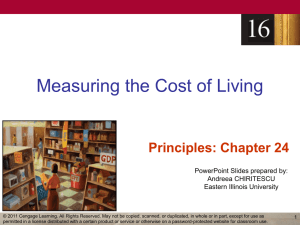
Chapter 6
Professor Yuna Chen
Consumer
Choice and
Demand
© 2015 Cengage Learning. All Rights Reserved. May not be copied, scanned, or duplicated, in whole or in part, except for use as
permitted in a license distributed with a certain product or service or otherwise on a password-protected website for classroom use.
1
6-1 Utility Analysis
• Utility
– Sense of pleasure
– satisfaction that comes from consumption
– Subjective
• Assumption
– Taste are given
– Tastes are relatively stable
© 2015 Cengage Learning. All Rights Reserved. May not be copied, scanned, or duplicated, in whole or in part, except for use as
permitted in a license distributed with a certain product or service or otherwise on a password-protected website for classroom use.
2
6-1a Taste and Preference
• Total utility
– Total satisfaction you derive from consumption
• Of consuming a particular good
• from all consumption
• Marginal utility
– Change in total utility from one-unit change in
consumption
© 2015 Cengage Learning. All Rights Reserved. May not be copied, scanned, or duplicated, in whole or in part, except for use as
permitted in a license distributed with a certain product or service or otherwise on a password-protected website for classroom use.
3
Classroom Experiment
Question: What is your dream car?
Knock, knock…
…
© 2015 Cengage Learning. All Rights Reserved. May not be copied, scanned, or duplicated, in whole or in part, except for use as
permitted in a license distributed with a certain product or service or otherwise on a password-protected website for classroom use.
4
6-1b Law of Diminishing Marginal Utility
• Law of diminishing marginal utility
– The more of a good consumed
• The smaller the increase in total utility
• Other things constant
• Marginal utility from each additional unit
– Declines as more is consumed
• Total utility increases as long as
marginal utility is positive
© 2015 Cengage Learning. All Rights Reserved. May not be copied, scanned, or duplicated, in whole or in part, except for use as
permitted in a license distributed with a certain product or service or otherwise on a password-protected website for classroom use.
5
6-2 Measuring Utility
6-2a Units of utility
– abstract concept rather than a concrete, observable
quantity.
– The "amount" of utility, therefore, are arbitrary,
representing a relative value
– Each person has a uniquely subjective utility scale
© 2015 Cengage Learning. All Rights Reserved. May not be copied, scanned, or duplicated, in whole or in part, except for use as
permitted in a license distributed with a certain product or service or otherwise on a password-protected website for classroom use.
6
6-2b Utility Maximization without Scarcity
• Goods are free if they are not scarce
– Increase consumption as long as marginal utility is
positive
• Two free goods
– Increase consumption of each good until the marginal
utility of each is 0
© 2015 Cengage Learning. All Rights Reserved. May not be copied, scanned, or duplicated, in whole or in part, except for use as
permitted in a license distributed with a certain product or service or otherwise on a password-protected website for classroom use.
7
Question
Cookies and drinks were offered in a party.
Valerie went to the party with her marginal utility of the first
cookie being 50, the 2nd one being 10, and the third being 0.
For the drinks, her marginal utility of the first cup is 20, the
2nd is 5, the 3rd is -10.
How many cookies and drinks did Valerie consume?
Answer: Valerie must have eaten 2 cookies, and
drank two cups of drinks.
© 2015 Cengage Learning. All Rights Reserved. May not be copied, scanned, or duplicated, in whole or in part, except for use as
permitted in a license distributed with a certain product or service or otherwise on a password-protected website for classroom use.
8
Case 1 Utility Maximization with Scarcity
• Goods are not free (price of movie = $6, price of cookie =
$3)
• Income – limited (Income = $30)
• How to maximize total utility?
© 2015 Cengage Learning. All Rights Reserved. May not be copied, scanned, or duplicated, in whole or in part, except for use as
permitted in a license distributed with a certain product or service or otherwise on a password-protected website for classroom use.
9
Table 1. TU and MU
Movies
Cookies
Q
TU
MU
Q
TU
MU
0
0
---
0
0
---
1
50
1
75
2
88
2
117
3
122
3
153
4
150
4
181
5
175
5
206
6
225
7
243
8
260
9
276
10
291
© 2015 Cengage Learning. All Rights Reserved. May not be copied, scanned, or duplicated, in whole or in part, except for use as
permitted in a license distributed with a certain product or service or otherwise on a password-protected website for classroom use.
10
Table 2
Choices
Movie
Cookie
TU
A
0
10
0+291 = 291
B
1
C
2
D
3
E
4
F
5
Choice _____ maximizes utility
•Consumer equilibrium - There is no way to increase utility by
reallocating the budget
•Any change to other choices will reduce utility
© 2015 Cengage Learning. All Rights Reserved. May not be copied, scanned, or duplicated, in whole or in part, except for use as
permitted in a license distributed with a certain product or service or otherwise on a password-protected website for classroom use.
11
Case 1
Case 1. Find MU per $ spent
Movies
Cookie
Q
MU
MUm/Pm
Q
MU
Muc/Pc
0
0
---
0
0
---
1
50
1
75
2
38
2
42
3
34
5.67
3
36
12
4
28
4.67
4
28
9.33
5
25
4.17
5
25
8.33
6
19
6.33
7
18
6
8
17
5.67
9
16
5.33
10
15
5
© 2015 Cengage Learning. All Rights Reserved. May not be copied, scanned, or duplicated, in whole or in part, except for use as
permitted in a license distributed with a certain product or service or otherwise on a password-protected website for classroom use.
12
6-2d Utility-Maximizing Conditions
Utility-maximizing condition:
– Last $ spent on each good yields the same marginal
utility
MU p
MU m
pp
pm
There is a typo in the formula in
textbook page 90.
© 2015 Cengage Learning. All Rights Reserved. May not be copied, scanned, or duplicated, in whole or in part, except for use as
permitted in a license distributed with a certain product or service or otherwise on a password-protected website for classroom use.
13
6-2d Utility-Maximizing Conditions
In terms of utility theory, “equilibrium” in the real
world means that households have spent their
incomes in such a way that their overall satisfaction
is maximized.
© 2015 Cengage Learning. All Rights Reserved. May not be copied, scanned, or duplicated, in whole or in part, except for use as
permitted in a license distributed with a certain product or service or otherwise on a password-protected website for classroom use.
14
6-2e MU and the Law of Demand
Recall Case 1. Income = $30, Pm = $6,
To max utility: Qm = 2
(Locate this in a diagram)
Case 2. Income = $30, Pm = $3
Find the utility max Qm
Qm = 5
(Locate this in a diagram)
© 2015 Cengage Learning. All Rights Reserved. May not be copied, scanned, or duplicated, in whole or in part, except for use as
permitted in a license distributed with a certain product or service or otherwise on a password-protected website for classroom use.
15
Example
Demand for Movie Generated From Marginal Utility
a
Price of movie
$6
b
3
D
0
2
5
Movie
Relationship between a demand curve and utility
maximization:
© 2015 Cengage Learning. All Rights Reserved. May not be copied, scanned, or duplicated, in whole or in part, except for use as
permitted in a license distributed with a certain product or service or otherwise on a password-protected website for classroom use.
16
Surprise!!!
Demand curve is a result of
utility maximization!
© 2015 Cengage Learning. All Rights Reserved. May not be copied, scanned, or duplicated, in whole or in part, except for use as
permitted in a license distributed with a certain product or service or otherwise on a password-protected website for classroom use.
17
Question
Suppose the price of a chocolate bar is $2 and the
price of a pack of chocolate chip cookies is $5.
Assuming the consumer is at equilibrium, and the
marginal utility of chocolate bar is 6, what is the
marginal utility of chocolate chip cookies?
Pb = $2
Pc = $5
MUb = 6
Muc = ?
© 2015 Cengage Learning. All Rights Reserved. May not be copied, scanned, or duplicated, in whole or in part, except for use as
permitted in a license distributed with a certain product or service or otherwise on a password-protected website for classroom use.
18
Answer
At equilibrium, the marginal utility per dollar spent
must be the same across all goods. Thus the
following equation must hold:
𝑀𝑈 𝑜𝑓 𝑐ℎ𝑜𝑐𝑜𝑙𝑎𝑡𝑒 𝑏𝑎𝑟
𝑀𝑈 𝑜𝑓 𝑐ℎ𝑜𝑐𝑜𝑙𝑎𝑡𝑒 𝑐ℎ𝑖𝑝 𝑐𝑜𝑜𝑘𝑖𝑒
=
𝑃𝑟𝑖𝑐𝑒 𝑜𝑓 𝑐ℎ𝑜𝑙𝑜𝑙𝑎𝑡𝑒 𝑏𝑎𝑟
𝑃𝑟𝑖𝑐𝑒 𝑜𝑓 𝑐ℎ𝑜𝑙𝑜𝑙𝑎𝑡𝑒 𝑐𝑜𝑜𝑘𝑖𝑒
6
𝑀𝑈 𝑜𝑓 𝑐ℎ𝑜𝑐𝑜𝑙𝑎𝑡𝑒 𝑐ℎ𝑖𝑝 𝑐𝑜𝑜𝑘𝑖𝑒
=
$2
$5
Marginal utility of chocolate chip cookie is 15.
© 2015 Cengage Learning. All Rights Reserved. May not be copied, scanned, or duplicated, in whole or in part, except for use as
permitted in a license distributed with a certain product or service or otherwise on a password-protected website for classroom use.
19
6-3a Consumer Surplus
• Consumer surplus
– The difference between what a consumer is
willing and able to pay and what the consumer
actually pays
© 2015 Cengage Learning. All Rights Reserved. May not be copied, scanned, or duplicated, in whole or in part, except for use as
permitted in a license distributed with a certain product or service or otherwise on a password-protected website for classroom use.
20
Example
Example: I am willing and able to pay $10 for a movie
ticket. At the theater, the ticket costs me $6.
What is my consumer surplus?
CS = $10 - $6 = $4
Question. I am willing and able to pay $2 for a chocolate
bar. The store is selling it at $4. What is my consumer
surplus?
- Will not buy it
- CS = 0
- CS can’t be negative
© 2015 Cengage Learning. All Rights Reserved. May not be copied, scanned, or duplicated, in whole or in part, except for use as
permitted in a license distributed with a certain product or service or otherwise on a password-protected website for classroom use.
21
6-3b Market Demand &Consumer Surplus
• Consumer surplus for the market
– Amount consumers are willing to pay
minus amount they pay
– Net benefit for consumers
– Economic welfare
© 2015 Cengage Learning. All Rights Reserved. May not be copied, scanned, or duplicated, in whole or in part, except for use as
permitted in a license distributed with a certain product or service or otherwise on a password-protected website for classroom use.
22
Example 2. How to calculate CS?
• If the market price is $10, how much is CS?
Price
$30
$10
D
0
100
Books
© 2015 Cengage Learning. All Rights Reserved. May not be copied, scanned, or duplicated, in whole or in part, except for use as
permitted in a license distributed with a certain product or service or otherwise on a password-protected website for classroom use.
23
• Question. What happen to consumer
surplus if price falls?
• Consumer surplus increases.
© 2015 Cengage Learning. All Rights Reserved. May not be copied, scanned, or duplicated, in whole or in part, except for use as
permitted in a license distributed with a certain product or service or otherwise on a password-protected website for classroom use.
24






